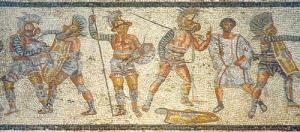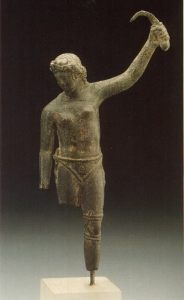
by fljustice | Oct 5, 2015 | Essays/Research, Gladiators, Gladiatrix, History
A Day at the Pompeii Arena
 It’s a sunny day in Pompeii on April 8th in this first year of the reign of Imperator Titus Caesar Vespasianus Augustus (AD 79). The crowds surge toward the amphitheater for the games given by D. Lucretius Stater Valens, a lifelong priest to the cult of the deified Nero Caesar Augustus. The placards pasted on the walls in the forum promise, “ten pairs of gladiators owned by his son D. Lucretius Valens and wild animal hunts, as permitted by law. The seats will be shaded with awnings.” Pompeii’s is the oldest stone amphitheater in the empire. For one hundred-fifty years it has proudly hosted games and religious festivals, but it’s looking dated next to the modern Flavian Amphitheater which will open next year in Rome. The frescoes of gladiatorial combat and beast hunts decorating the walls surrounding the sand are fading, but the patrons come for the blood sports, not the art.
It’s a sunny day in Pompeii on April 8th in this first year of the reign of Imperator Titus Caesar Vespasianus Augustus (AD 79). The crowds surge toward the amphitheater for the games given by D. Lucretius Stater Valens, a lifelong priest to the cult of the deified Nero Caesar Augustus. The placards pasted on the walls in the forum promise, “ten pairs of gladiators owned by his son D. Lucretius Valens and wild animal hunts, as permitted by law. The seats will be shaded with awnings.” Pompeii’s is the oldest stone amphitheater in the empire. For one hundred-fifty years it has proudly hosted games and religious festivals, but it’s looking dated next to the modern Flavian Amphitheater which will open next year in Rome. The frescoes of gladiatorial combat and beast hunts decorating the walls surrounding the sand are fading, but the patrons come for the blood sports, not the art.
The spectators pass into the open spaces surrounding the arena where merchants and food vendors hawk their wares. The scent of fresh bread, roasted meats, and sour wine waft through the crowd to mingle with the odor of sweat and hair pomade. People look at their wooden tickets and enter the appropriate gate to spread throughout the amphitheater: the front rows reserved for the leading citizens; the middle for the lesser knights and merchants; and the top for the poor, slaves, and women. Some resent the class divisions at the arena. At the chariot races in the hippodrome, it’s open seating (except for the emperor, of course!) and women mix with the men. (more…)

by fljustice | Sep 9, 2015 | Essays/Research, Gladiators, Gladiatrix, History, Movies
Busting Gladiator Myths
Before I researched my novel, Sword of the Gladiatrix, I got most of my ideas and impressions of gladiators from the media: Russell Crowe in Gladiator and (for those of us of a certain age) Kirk Douglas in Spartacus. More recently Starz had a fantastic (in more ways than one) show that ran for three seasons titled Spartacus: War of the Damned. All of these shows perpetuate some gladiator myths that I hope to bust wide open in this post. They also got a couple of things right, which I’ll point out.
Myth #1:
All gladiators were men.

Bronze statue of a gladiatrix
Most were, but not all. Here I’ll give Gladiator a weak thumbs up—they had women in chariots fighting against a group of men in a re-enactment of a classic battle in an arena scene, but other than that, women gladiators don’t show up in most visual media. It’s left to us lowly writers to correct the balance. If you look closely, women in the arena show up in art, literature, and law.
Sword of the Gladiatrix was inspired by a particular stone carving of two female gladiators in the British Museum. More recently, archaeologists have uncovered a bronze statue of a gladiatrix holding a sica—a curved sword. Tacitus, Suetonius, Dio, Martial, and Juvenal all write about female gladiators—usually (except for Martial) with some element of dismay or sarcasm. An organizer in Ostia brags on his tombstone that he was the first person to put women in the arena as fighters. My favorite evidence is in the law: The first Roman Emperor Augustus forbade recruiting noble and free women as gladiators. Nearly two hundred years later, Emperor Septimus Severus banned single combat by women in the arena. If women weren’t being recruited and fighting, why have a ban? Human nature being what it is, these prohibitions probably made the fights all the more popular because they were illegal. I’m sure female gladiatorial contests continued for some time. (more…)

by fljustice | Mar 11, 2015 | Essays/Research, History, Wonderful Women
Boudica, Warrior Queen
It’s Women’s History Month and I’ve exhausted my favorite topic of Hypatia, Lady Philosopher of Alexandria. Time to move on to another fascinating woman who has been extensively mythologized: Boudica, Queen of the Iceni (a British Celtic tribe) in the first century AD. For those of you unfamiliar with her story, here is a brief summary.
Some Background

Image of Boudica in stained glass in Colchester Town Hall.
Julius Caesar invaded Britain in 55 BC and again in 56 where he had some military success against local tribes. He withdrew to Gaul and never returned to Britain. Roman influence in Britain grew over the next 80 years due to increased trade. The British tribes quarreled and Caratacus, the leader of the Catuvellauni expanded his tribe’s territory at the expense of the Atrebates. The Atrebates chief Verica appealed to Rome and gave the Emperor Claudius an excuse to invade Britain in AD 43. General Plautius led the assault and Claudius joined him with reinforcements. They took Caratacus’ stronghold Camulodunum (modern Colchester) and established the first Roman colonia—towns founded for Roman citizens—on British soil. Eleven tribal kings surrendered. Claudius declared Britain a Roman province.
Caractacus continued to fight, leading the western tribes in Wales in guerrilla actions against Plautius’ successor Scapula, known for his brutal pacification campaign in the south. Scapula finally defeated Caractacus in 51. Caractacus fled a to the Brigantes tribe (in modern-day Yorkshire) but was betrayed by their Queen Cartimandua and handed over to the Romans. In 59 and 60, the Roman governor Caius Suetonius Paulinus (during Nero’s reign) led the successful invasion and pacification of Wales and the Isle of Anglesey, the seat of the Druids. (more…)

by fljustice | Jul 24, 2011 | History in the News
History in the News:
Bible Stories, Recovered Artifacts and “Raiders” Turns 30

1C Relief in British Museum
You can’t kick a stone in the Middle East without uncovering an artifact. It’s an archaeologist’s paradise and a diplomat’s nightmare. When it comes to biblical-related stories, there’s always a furor. Does this artifact “prove” Jesus lived or does this inscription substantiate the story of David and Goliath? The past couple of months provided several stories touching on biblical narratives. The trend in returning looted artifacts to their rightful home is continuing with a couple of good news stories. Finally, it’s been thirty years since Indiana Jones made archaeology sexy in “Raiders of the Lost Ark.” But Dr. Jones preferred a bull whip and pistol to scientific methods. We’ll see what scientific innovations have evolved since Indy’s time. First story in our lineup: the city of Shekhem; supposedly the final burial site of Joseph of the many-colored coat. (more…)

by fljustice | Apr 8, 2011 | History in the News
History in the News:
Libya’s Treasures, Pickled Bog Brain, and Agatha Christie

Arch of Roman Emperor Lucius Septimius Severus at UNESCO World Heritage Site: Leptis Magna, Libya
The United Nations Educational, Scientific and Cultural Organization (UNESCO) is calling on all sides in the Libya conflict to protect North Africa’s wealth of ancient treasures. Five Libyan sites are on UNESCO’s World Heritage List, including the Roman ruins of Leptis Magna and the ancient Phoenician trading post of Sabratha, close to the capital Tripoli. In the rebel-held eastern section, the ancient mountain city of Cyrene is vulnerable. (Map of threatened areas. Link to original story.)
Under the Qaddafi regime, the ancient Roman and Greek cities dotting the Mediterranean coast have suffered from neglect. Qaddafi preferred to develop the oil of his country (Libya has about 2% of the world’s reserves) and little money was spent on developing the tourist industry or protecting important archaeological sites. Sheep are penned in the Greek theater at Cyrene and goats roam the ruins. Locals are hoping that tourism will bring some prosperity to their area when hostilities cease. (Link to original story.) (more…)

 It’s a sunny day in Pompeii on April 8th in this first year of the reign of Imperator Titus Caesar Vespasianus Augustus (AD 79). The crowds surge toward the amphitheater for the games given by D. Lucretius Stater Valens, a lifelong priest to the cult of the deified Nero Caesar Augustus. The placards pasted on the walls in the forum promise, “ten pairs of gladiators owned by his son D. Lucretius Valens and wild animal hunts, as permitted by law. The seats will be shaded with awnings.” Pompeii’s is the oldest stone amphitheater in the empire. For one hundred-fifty years it has proudly hosted games and religious festivals, but it’s looking dated next to the modern Flavian Amphitheater which will open next year in Rome. The frescoes of gladiatorial combat and beast hunts decorating the walls surrounding the sand are fading, but the patrons come for the blood sports, not the art.
It’s a sunny day in Pompeii on April 8th in this first year of the reign of Imperator Titus Caesar Vespasianus Augustus (AD 79). The crowds surge toward the amphitheater for the games given by D. Lucretius Stater Valens, a lifelong priest to the cult of the deified Nero Caesar Augustus. The placards pasted on the walls in the forum promise, “ten pairs of gladiators owned by his son D. Lucretius Valens and wild animal hunts, as permitted by law. The seats will be shaded with awnings.” Pompeii’s is the oldest stone amphitheater in the empire. For one hundred-fifty years it has proudly hosted games and religious festivals, but it’s looking dated next to the modern Flavian Amphitheater which will open next year in Rome. The frescoes of gladiatorial combat and beast hunts decorating the walls surrounding the sand are fading, but the patrons come for the blood sports, not the art.






